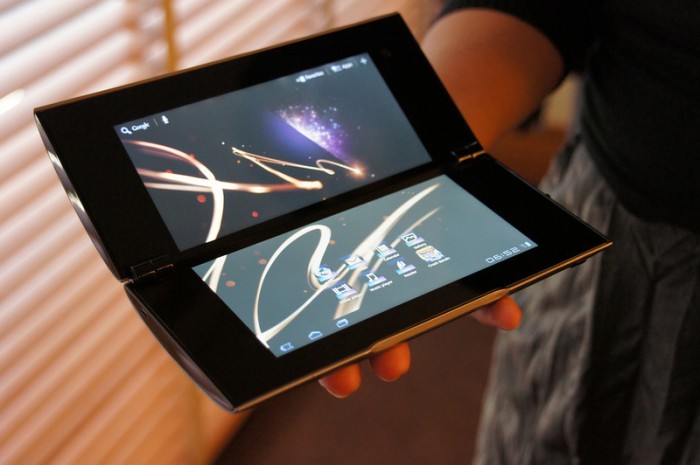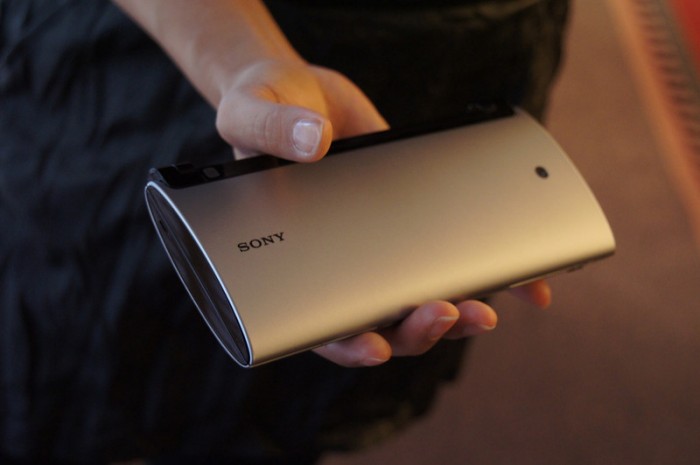When Sony provided a sneak peek last week of the two new tablets it plans to launch later this year, it also offered a glimpse into the unspoken imperative it faces: Because it’s late to the game, trailing Apple by, um, years, and others, like Samsung, by months, its biggest hope to gain a toehold in the ever crowded field of similar devices is to do something different — really different.
And different it’s done, as least so far as the second of its tablets is concerned — the one code-named Sony Tablet S2, a dual-screen clamshell device that bears no resemblance whatsoever to a tablet, not to the paper versions that make for the namesake crop of thin flat slates, to put it another way, such as the Apple iPad, the Samsung Galaxy Tab, the Motorola XOOM, or the BlackBerry PlayBook, to names just a few.
Sony hasn’t gone totally rad. It’s also launching the Sony Tablet S1, a tablet that looks every bit like one — except for one interesting (note I didn’t say revolutionary) design twist: It’s shaped like a wedge — it looks like a magazine with the cover folded back behind it — which, Sony says, changes the center of gravity to make it easier to hold in one hand.
Form factor alone isn’t the only thing Sony is using to differentiate its tablets. Both will come with two exclusively Sony software enhancements. The first, called Quick View, renders Web pages more quickly, while the second, called Quick Touch Panel, makes the screen smoother and more responsive to touch commands.
What’s more, Sony is bringing on something Samsung, Motorola or RIM can’t — its own libraries of movies, music, ebooks and games. It showed off the S2 running a Playstation game with the controls on one screen and the game display on another. The tablets are Playstation certified, meaning that they’ll run some 40 to 50 PS titles right out of the chute.
Those are indeed distinguishing features. But hardly knock-your-socks-off new. If there’s anything majorly different it’s the S2’s size and shape, which is unlike anything I’ve seen in any so-called tablet so far.
Unlike the S1, a WiFi-only device, the S2 will offer WiFi and broadband connectivity and will be sold by AT&T exclusively, making it appear to be the device on which Sony is pinning its biggest bet for taking its rightful place in a segment that could account for 50 million unit sales next year alone.
And there’s something else to note about the S2. After the briefing I sidled up to Kunimasa Suzuki, an exec from Sony Corp.’s Tokyo headquarters who’s leading the company’s push into tablets, and asked, “What insights into the market led Sony to create the S2 clamshell?”
His reply was surprising but telling: No, it wasn’t based on research about what consumers wanted or needed but resulted instead, he said, from the inspirations of its engineers.
It was surprising insofar that Sony Electronics of America, its U.S. manufacturing arm, has been emphasizing thorough consumer research as a prerequisite to product development, a departure from a what had been a characteristically Sony modus operandi dating back to its legendary founders Masuro Ibuka and Akio Morita, who made it a core company value to stress engineering inventiveness over profits, let alone market research.
The question is though: Have Sony engineers anticipated what you want, or need, even before you do? They did back then, giving the world the Walkman and a string of other preceding and ensuing electronic hits. But this is now.
I have my doubts. Then again, I alone a market do not make. You do, though. So let’s hear from you. Will the dual-screen, clamshell S2 set a new standard for portable computing-communicating devices? Or will it go down as a good, but errant, try at thinking different.
Give Sony some of the consumer research it apparently lacked in creating its new tablets. Tell them what you think by commenting.


